What to Know
- In addition to public and private schools, nonessential businesses in nine hotspot ZIP codes in Brooklyn and Queens have been ordered to close; indoor dining will be shuttered in some places as well, while mass gatherings have been banned
- The clusters' effects are starting to become more tangible; ER visits for COVID-like illnesses are on the rise. The city's daily case average has soared and its rolling positivity rate continues to inch up
- The NYC clusters and those in Rockland and Orange counties are also affecting statewide numbers; hospitalizations hit their highest number Tuesday since July 22 (705) and the positivity rate is up
New York is ramping up its crackdown on COVID-19 hotspot "clusters" with new rules that include school and business closures, bans on mass gatherings and restrictions on restaurants, Gov. Andrew Cuomo said Tuesday.
New York state reported its highest total hospitalizations Tuesday (705) since July 22 and its rolling seven-day positivity rate is slowly inching up as well. The change is starker in the city.
Cuomo announced what he called a "Cluster Action Initiative" to try and combat the virus's spread -- essentially, concentric rings with different levels of restriction, centered on clusters based on the number of cases. He identified one such cluster in south Brooklyn and two in Queens, with a central area (red), a surrounding area (orange) and a precautionary area (yellow). There are other clusters upstate as well.
In red areas, mass gatherings are prohibited, schools and non-essential businesses are closed, dining is takeout only and houses of worship are limited in capacity. Schools in orange zones would also be closed and mass gatherings limited there. Schools in the yellow zones can be open with mandatory weekly testing for students and staff.
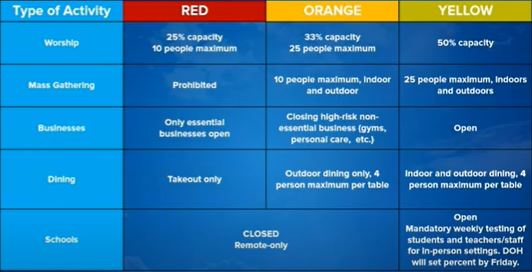
The rules will go into effect sometime between Wednesday and Friday, in consultation with local governments -- which will have to provide the state with personnel to enforce compliance. (New York City will be on the hook to contribute 400 people to a task force, Cuomo said.)
The clusters are mapped to be relatively small, he added -- perhaps a mile in diameter in the red area and maybe two miles in diameter across all three levels.
"There is no one who can say they didn't see this coming," the governor said at a news conference from Albany.
Cuomo stressed that houses of worship are a significant source of spread for the virus, and that the new rules will apply equally to them. He specifically mentioned the Orthodox Jewish community, whose leaders he met with Tuesday to ensure compliance in communities at the heart of some of the state's clusters.
Cuomo's actions came as the situation in New York City worsened. Mayor Bill de Blasio added a 13th ZIP code to the watchlist Tuesday. as daily case averages topped 500 for the first time in some time, and doubled down on the need for severe restrictions to contain further spread. Combined, new cases from the watchlist ZIP codes and the nine hotspots have accounted for more than 40 percent of all citywide cases over the last two weeks, officials said.
"The facts on the ground are clear. We need restrictions to stop this problem," de Blasio said in his daily briefing. "If we all do what's right as we did before, we keep moving forward. If we do it wrong, it endangers the whole city."
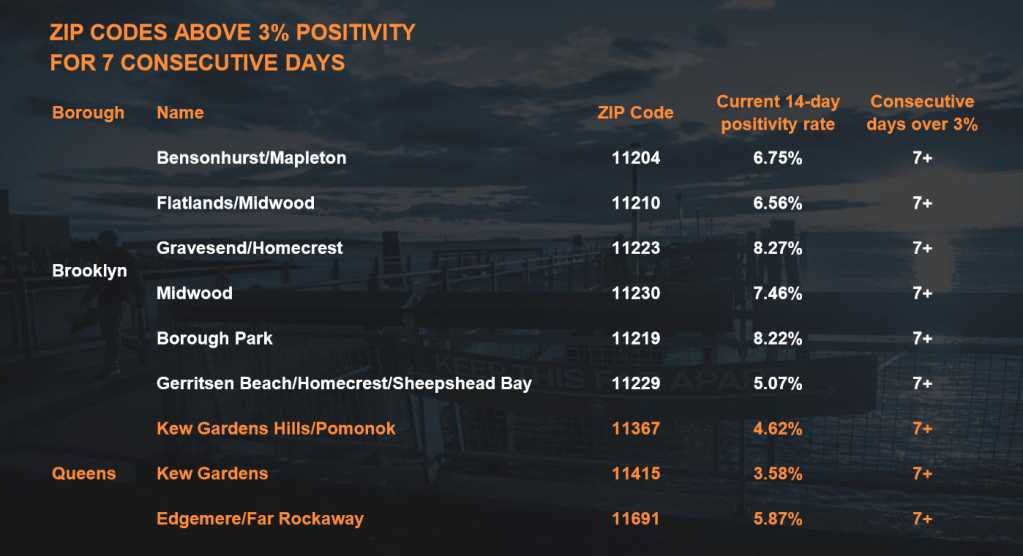
New York City identified nine ZIP codes where officials proposed to close non-essential businesses and schools to prevent the further spread of coronavirus
The mayor described the shutdowns Tuesday as a "necessary rewind" to prevent a potential second wave from overspreading the entire city like the first one did this spring. In an interview with NY1 the night before, de Blasio said he had been hopeful outreach and enforcement efforts would work as they did in some other neighborhoods in August and September. They have failed in this case, he said.
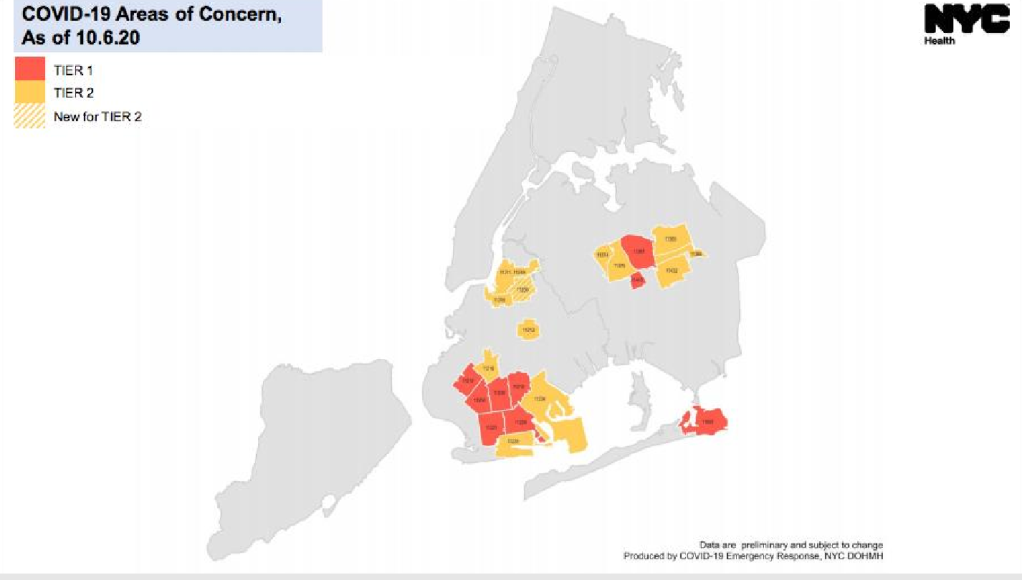
NYC has broken certain ZIP codes into two tiers. Tier 1 is for viral hotspots subject to closure. Tier 2 is for watchlist ZIP codes.
The nine hotspots are accounting for a quarter of new COVID cases citywide over the last two weeks, despite representing just 7.4 percent of the population. The clusters have already begun to expand to nearby neighborhoods; two of the now 13 ZIP codes on the watchlist are on the brink of the shutdown threshold. South Williamsburg (11206) became the latest addition to the watchlist Tuesday.
The initial slate of governor-ordered school closures targeted nine ZIP codes where the COVID positivity rate has topped 3 percent over a seven-day rolling period. Many of the ZIP codes have been well above that threshold for some time.
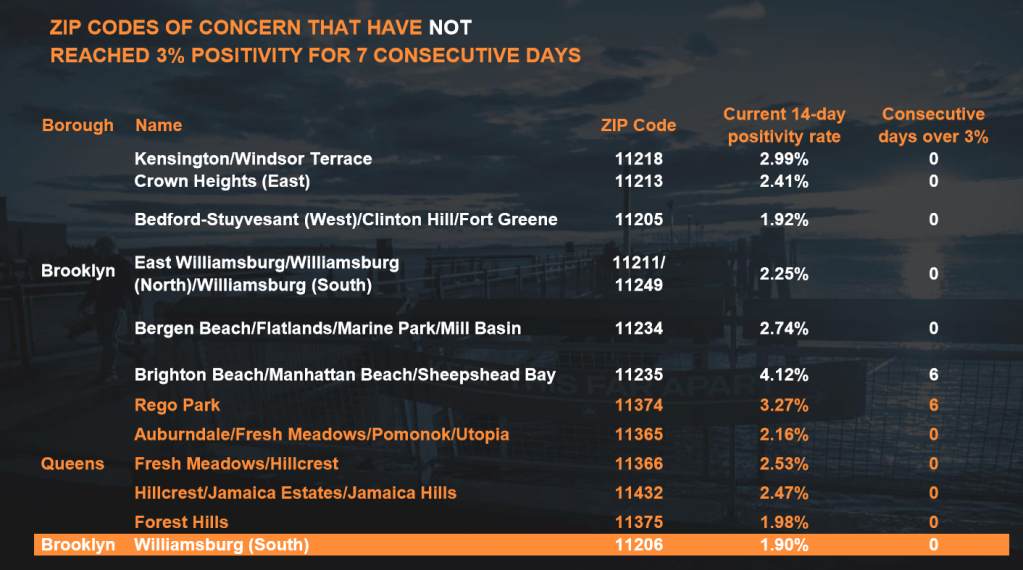
These are the 13 ZIP codes on the city's watchlist. They have yet to meet criteria for closure but are showing signs of COVID case increases.
While some of the watchlist ZIPs have yet to see a single day with positivity rates of 3 percent or higher, two have seen six straight days of that as of Tuesday, meaning new shutdowns could come by Wednesday if the trend continues.
Daily Percentage of Positive Tests by New York Region
With all of New York state in some phase of reopening, Gov. Andrew Cuomo is shifting his focus to monitoring test results on a daily basis across each region to identify potential hotspots before they emerge. Here's the latest tracking data by region. For the latest county-level results statewide, click here
The clusters have most certainly become a problem -- one that becomes more apparent with each passing day, as the health indicators show. The city's daily average COVID caseload has ticked up steadily over the course of the week and topped 500 for the first time Tuesday after averaging about half that for quite some time. Emergency departments citywide are seeing a slight uptick in visits for COVID-like illnesses over the last week, the health department said.
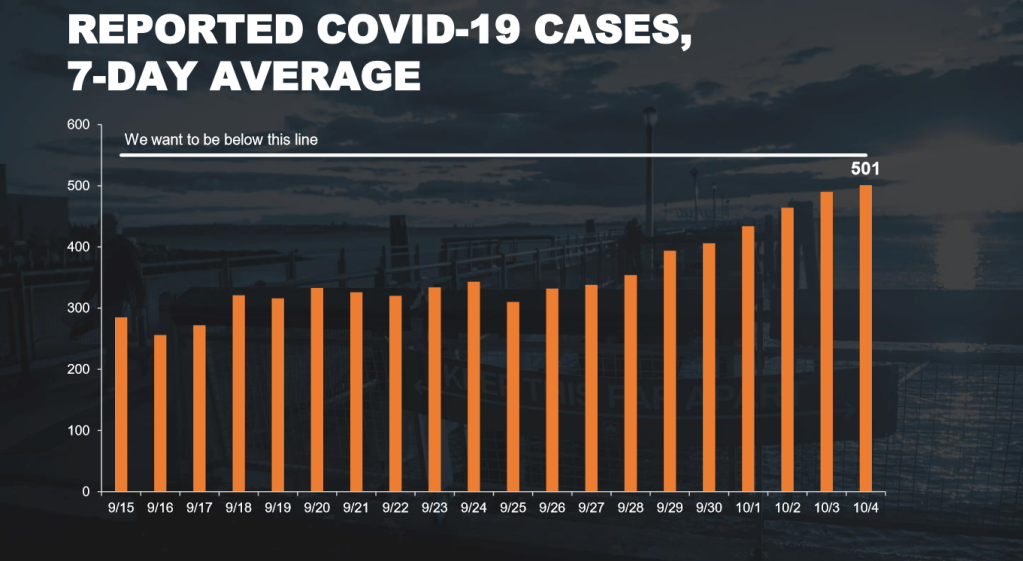
The clusters are contributing to a steady rise in New York City's overall daily case average.
Health officials declined to identify specific hospitals seeing ER visits rise, though said in a statement, "With COVID19, increases in hospital visits generally follow an increase in cases. Data show we are starting to see an uptick in the number of hospitalized patients in two hospitals in Brooklyn and at least one in Queens."
The city's seven-day rolling positivity rate is also up. It hit 1.65 percent Tuesday and is inching closer and closer to 2 percent, which is de Blasio's threshold for shuttering indoor dining across all five boroughs.
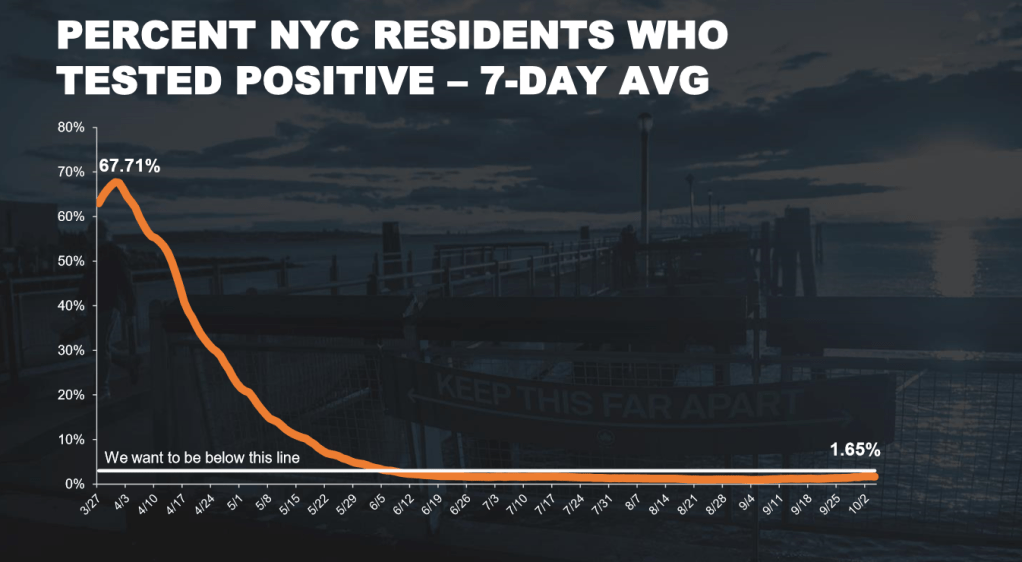
The citywide rolling positivity rate remains comparatively low, but has ticked up steadily in recent weeks.
Statewide, New York's infection rate remains relatively low though is ticking up, hitting 1.4 percent Tuesday. The seven-day rolling positivity rate remains at 1 percent, though will likely increase in the coming days -- a hard turn just weeks after the state came off a 38-day stretch of infection rates below 1 percent.
Even without the clusters, Cuomo has said he doesn't believe that low infection rate, one of the lowest in the United States, is sustainable through fall. Fall means chillier weather and more indoor activities. It means flu season. It means schools -- if they can manage to safely stay open.
New York Gov. Andrew Cuomo says he’s ordering schools in certain New York City neighborhoods closed Tuesday in an attempt to halt a flare-up of the coronavirus. NBC New York's Katherine Creag reports.
In Orange County, the health commissioner issued an order Monday mandating the closure of all public, private and religious schools if the seven-day rolling positivity rate exceeds 9 percent in a given area. As of the state's last update, one ZIP code in the county (10950) had far exceeded that metric already.
At the same time, COVID cases around the country and the world don't appear to be on the decline either. President Donald Trump and many in his inner circle have now been diagnosed with the novel coronavirus. The World Health Organization estimates up to 1 in 10 people worldwide may have had COVID-19 at some point, which is more than 20 times higher than the number of confirmed cases.
Travel is a continued threat to the tri-state area's progress, even as New York and New Jersey grapple with concerning upticks anew at home. The quarantine order Cuomo, Gov. Phil Murphy and Gov. Ned Lamont jointly implemented in late June remains in effect, requiring travelers from U.S. hotspots to isolate for 14 days before entering the tri-state area. Travelers must also fill out contact tracing forms; the order applies to local residents who have visited hotspots as well.
The number of U.S. states and territories from which travelers arriving to the tri-state area must quarantine for 14 days stands at 34. It will be updated Tuesday, but for now, the quarantine order covers Alaska, Alabama, Arkansas, Colorado, Delaware, Florida, Georgia, Guam, Iowa, Idaho, Illinois, Indiana, Kansas, Kentucky, Louisiana, Minnesota, Mississippi, Missouri, Montana, Nebraska, Nevada, North Carolina, North Dakota, Oklahoma, Puerto Rico, Rhode Island, South Carolina, South Dakota, Tennessee, Texas, Utah, West Virginia, Wyoming and Wisconsin.
"Shut" - Google News
October 06, 2020 at 09:47PM
https://ift.tt/30DpwBm
NY to Shut Schools and Businesses, Ban Mass Gatherings as Cluster Fight Intensifies - NBC New York
"Shut" - Google News
https://ift.tt/3d35Me0
https://ift.tt/2WkO13c
Bagikan Berita Ini















0 Response to "NY to Shut Schools and Businesses, Ban Mass Gatherings as Cluster Fight Intensifies - NBC New York"
Post a Comment